Kakheti
Kakheti is a region in eastern Georgia, famous for great weather, golden hills, and Georgia's principal wine country.
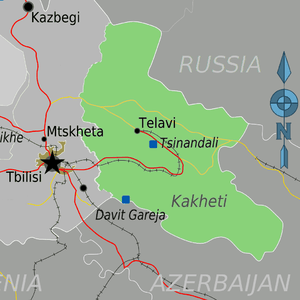
Cities
- 🌍 Gurjaani – one of the centres of Georgia's wine industry. Landmarks include the Church of the Dormition aka Church of All Saints (Kvelatsminda; 8th-9th century), Museum of Local Lore and History, the Museum of Nato Vachnadze, and the historic mud-cure resort of Akhtala.
- 🌍 Sighnaghi – a restored wine town with an Old Town, the Pirosmani Museum and an extensive fortifications, as well as the Bodbe Monastery (aka Bodbe Convent or St. George of Bodbe) on its outskirts.
- 🌍 Telavi – the capital of Kakheti is a convenient base for exploring the region's wineries, castles, and monasteries, in features the palace of King Erekle II, an ethnographic museum and a famous 900-year-old plane tree. Nearby are an old and popular fortress, the Alaverdi Cathedral. Telavi is the basis for exploring the mountains of Tusheti.
- 🌍 Tsinandali – featuring Tsinandali Palace-museum, historic winery which once belonged to the 19th-century aristocratic poet Alexander Chavchavadze, and many trees similar to the very old one found in Telavi.
- 🌍 Kvareli – known for its Kindzmarauli wine and as the birthplace of Georgian author Ilia Chavchavadze, whose fortified house here is preserved as a local museum.
- 🌍 Mukuzani – A wine town known for its white grapes and wine of the same name.
Other destinations
- 🌍 Pankisi Gorge – a bit of an infamous section of Georgia, after Russia claimed Chechen terrorists were using it as a base for attacking Russians in Chechnya, but the gorge is now safe and still home to many Chechen refugees–probably the safest place in the world to experience Chechen culture.
- 🌍 Lagodekhi – a pretty border town on the road to Sheki, Azerbaijan, near the beautiful national park with the same name (see #Do below)
- 🌍 Omalo – a village up in the mountains of Tusheti
Understand
Kakheti (კახეთი) is a historical province in eastern Georgia. Kakheti, and especially the Alazani valley, is the biggest wine region of Georgia and is consider the cradle of wine. The legend states that from here the wine spread all over the world. And indeed, the main attraction of that region, besides the old churches and monasteries, are the hundreds of small and large, modern and ancient wineries, partly still run family owned.
Also read #Drink below to better understand the importance of this wine region.
The official website of this region is: http://www.kakheti.gov.ge/
Talk
Georgian is unquestionably the main language in the region, but much of the older generation speak Russian and the younger generation is increasingly speaking English due to hostility towards Russia, and also because English is taught in schools since independence and has replaced Russian as a second language in schools nation-wide. When in need for help, look for younger people, as they are more likely to know some English.
If you happen to speak Chechen, you could have a very interesting experience in Georgia's Pankisi Gorge, where many Chechen refugees have set up shanties.
Get in
By bus
The bordering Georgian region to the west is Kartli, which has several (mini)buses every day running between Tbilisi and mainly Telavi, Gurjaani or Sighnaghi.
The main route is by Gurjaani, but for Telavi it is faster take the turn before Sartichala and across the Gombori Pass.
Coming from the east, it is possible to enter Georgia (and Kakheti) from Azerbaijan with minibuses from (and to) Qax (Qakh) and Zaqatala, which travel through Kakheti and mostly further to Tbilisi – read there.
By car
There are two options to get into Kakheti from the west. One is highway no. 5 and no. 42 by Gurjaani The other and newer option is highway no. 38, departing shortly after the Tbilisi city border near Vaziani north from highway no. 5. The latter one is via the Gombori Pass and can be slow due to the many turns and serpentines. In winter and with snow it is recommended to take the former route.
The road between Akhmeta and the Georgian Military Highway, via Tianeti, can only be done by 4WD.
Get around
Generally, everything is true what is mentioned under the same section in the Georgia country article.
Within Kakheti, several marshrutkas travel between the major cities and towns of that region. For Tusheti you have to hire a Jeep / 4WD with driver for about 200 lari.
Of course, travelling by car is an option, and so is hitch-hiking.
See
- 🌍 David Gareja (70 km southeast of Tbilisi and probably best reach from there. Good for a 1/2 day stop when coming/going from/to Sighnaghi). A 6th century cave monastery clinging onto a rocky hillside lying meters away from Azerbaijan, with beautiful frescos.
- 🌍 Alaverdi Monastery (Basilica of Alaverdi, St. George Cathedral) (Georgian: ალავერდი, ალავერდის მონასტერი, ალავერდის ტაძარი) (Near the village with the same name, 15 km northwest of Telavi. Marshrutkas depart roughly hourly from Alazari Avenue in Telavi for 1.3 lari and take ±30 minutes. To get back, wait in front in the cathedral for the next marshrutka.). Built in the 11th century by the order of King Kwirike III. (King of Kakheti), reaching 50 m into the sky, this is the second highest cathedral and third highest church in Georgia (after the Sameba cathedral and the Svetitskhoveli cathedral, respectively). Before it, another monastery was standing here, built during the 4th century by Ioseb Alaverdeli (Ioseb of Alaverdi). Free.
- 🌍 Tusheti National Park. A mysterious, remote region high in the mountains bordering Chechnya with ancient pagan and Christian monuments; to go here is to wander back in time hundreds of years. Famous for its historic towers.
- 🌍
Ikalto Monastery (7 km west of Telavi). A former academy and now monastery, it was founded by Zenon Iqaltoeli on in the 2nd half of the 6th century. Zenon Iqaltoeli was a Christian religious founder and one of so called 13 Assyrian fathers, also buried inside of the monastery. In the 12th century, the theologian Arsen Iqaltoeli, which studied at Mangana in Constantinople and worked together with Johannes Petrizi, founded the academy on the orders of King David. For centuries the academy was the cultural centre of Geprgia, teaching theology, philosophy, astronomy, rhetoric, law and mathematics. The monastery was also used as a winery and a smithy. In 1616 the academy was destroyed by Shah Abbas I.
In 1938 the grounds were examined, and the ruins of 59 buildings, several craft businesses and one pressing plant were found. Nowadays, the monastery contains three churches and the ruin of the academy. The main church, Chwtaeba (holy ghost), originates from the 8th century.
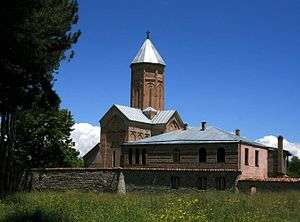
- 🌍 Shuamta Monasteries (close to Ikalto and 10 km west of Telavi along the road to Tbilisi). This complex contains Akhali and Dzveli Shuamta, which were renovated in 2008, including a paved road for access.
- Akhali (new) Shuamta (Georgian: ახალი შუამთა; ɑχɑlɪ ʃʊɑmtʰɑ), 3 km from the highway, is a Georgian orthodox nunnery from the 16th century, which was founded by the wife of Kind Levan II., Tinatin, due to Old Shuamta slowly falling apart. Tinatin was also buried in Akhali Shuamta.
- Dzveli (old) Shuamta (Georgian: ძველი შუამთა; d͡zvɛlɪ ʃʊɑmtʰɑ), another 2 km further, contains a basilica from the 5th century as well as two churches from the 7th century. The bigger one of the churches is similar to the Jvari Monastery near Mtskheta. Dzveli Shuamta was abandoned during the 16th century and only repopulated recently.
- 🌍 Gremi Cathedral (Georgian: გრემის ტაძარი) (10 km northeast of Telavi, minibuses from Telavi towards Gremi, Shilda and Kvareli pass by the cathedral (2 lari), a taxi should be around 10 lari). A fortified fantasy castle and Georgian orthodox cathedral upon a large rock in front of the mountains with a church on top. The cathedral was erected in 1565 by King Levan. The frescos are from 1577. Built from bricks and simultaneously being a fortress, the cathedral has three entrances, a western, southern and northern one. Before it was built, the tower, still there today as bell tower and detached from the rest, was the only thing standing there.
.jpg)
- 🌍
Nekressi (Georgian: ნეკრესი; nɛkʼrɛsɪ) (10 km west of Kvareli and 35 km northeast of Telavi). An archaeological site and monastery near Shilda. The city was founded in the 1st or 2nd century B.E. by the King of Iberia, Parnadshomi. During the 4th century, King Mihrdat built a church here, which was later, in the 6th century, inhabited and used by one of the 13 Assyrian fathers, Abibos Nekresseli. During this time, the bishopric of Nekressi was founded, which lasted until the 19th century. Due to its strategically favourable location, Nekressi became an important city in this region, serving as a centre for education and hagiography.
Nekressi consists of several churches and related buildings. The little basilica from the 4th century is one of the oldest still remaining churches in Georgia. Another larger basilica from the 7th century represents the three church basilica type, an independent kind of architecture for Georgian churches. During the 8th century, another church with a dome was erected in Nekressi. The monastery also houses a two-storey bishop palace from the 8/9th century. Furthermore, in the 16th century a tower was built here. Parts of the historical city have been excavated and can be visited.
There is a car park 2.5 km before the monastery, where also you can find the excavated site. From here, it is a steep climb up to the monastery. Alternatively, you can use the shuttle bus between the carpark and the monastery (1 lari).
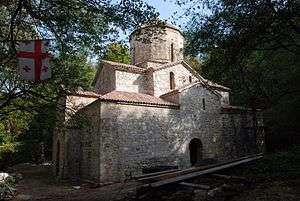
- 🌍 Vachnadziani Church of All Saints / Vachnadziani Kvelatsminda (ვაჩნაძიანის ყველაწმინდა) (Between Telavi and Gurjaani). The Church of the Mother of God built in the 9th century with a complex architecture. It combines a three church basilica and the central building with a high dome. Based on this type of building, many Georgian churches were built starting from the 11th century.
- 🌍 Ujarma Castle (უჯარმისციხე) (a few km north of Ujarma (უჯარმა) village, on the highway no. 38 to Gombori Pass / Telavi). Ruins of a fortress near 🌍 Sartichala, a former settlement of Germans from Baden Württemberg, who called it Marienfeld. The castle was built during the 3-4th century with the town below to safeguard the canyon of the Iori river against the Persians and Arabs. During the reign of Vakhtang I of Iberia, the castle was extended and used as his residency. In 914, Ujarma was conquered by the Arabs, and the castle was destroyed consequently. In 12th century the castle was rebuilt and renovated by Georgian King Giorgi III., but repeatedly destroyed in the following centuries.
- 🌍 Tsinandali Gardens. 10:00-19:00 (winter time 10:00-17:00). The residential palace of the Chavchavadzes family. It has a charming garden of a medium size. 2 lari - entrance to the park; 5 lari - entrance to the park + ticket to the museum (incl. guide service).
- 🌍 Basilica of Vazisubani (St. Mariam Church / წმინდა მარიამის სახელობის), Vazisubani.
- 🌍 Khornabuji fortress (40 km southeast of Sighnaghi, near Dedoplitskaro village). This is an ancient fortification on the rocks, first mentioned in V century. It was invaded by Mongols in XIII century.
- 🌍 Sabatsminda Church, Kardenakhi. Ruins from a 13th century church.
- 🌍 Ninotsminda Monastery.
Do
.jpg)
This region is famous for its wine route, notably Tsinandali, Gurjaani and Kvareli, as well as the hiking opportunities in its three national parks / nature reserves, especially Tusheti.
- 🌍 Alaverdoba. End of September. The wine harvest festival is happening all around Alaverdi Monastery every September. It takes place several days and reaches its peak on 28th September, the day of the holy Ioseb Alawerdeli (Joseph of Alaverdi). This festival has been a tradition and popular for centuries and even survived the Soviet Union.
- Hike 🌍 Lagodekhi Nature Reserve with its subtropical forests and find one of most beautiful waterfalls in Georgia. There are some guest houses available in the park. With some luck you may see bears, deer or leopards if you hike in the early morning.
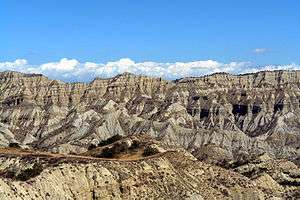
- 🌍 Vashlovani National Park, famous for hiking and bird watching.
- Hike 73 km along the Russian border from Omalo (Tusheti) to Shatili (Stephantsminda), see Tusheti.
- 🌍 TEMI Bicycle Rental, ☎ +995 591633633, e-mail: sales@temi-community.org. Rents bicycles for self-guided trips through the nearby vineyards of Gremi. 20 lari p.P..
- Rafting and canoeing. ...along the Iori river.
Eat
- 🌍 Kachreti Champion (კაჭრეთის ჩემპიონი). Restaurant is located right on the Kakheti Highway. It offers local Kakhetian cuisine. It has open-area seats. The food is delicious but buying wine is not worth it. It has become very popular with locals and tourist, and now even boasts a branch with the same name in Tbilisi. US$10 per person.
- 🌍 Tschakuna Papas Dukani (ჩხაკუნა პაპას დუქანი) (along the highway no. 5, 500 m southwest of the Iori bridge), ☎ +995 790613110. Nice restaurant with garden, as well as affordable and decent cuisine (delicacy: Chaschlama). Gets very busy during weekends, so better to reserve ahead or try Salchino Restaurant across the road.
- Underneath the Ujarma Castle, there are several picnic tables with fire places, where you can grill your own Mzwadi.
Drink
Great drinking opportunities await visitors to Kakheti. The most important wine villages are Tsinandali, Kvareli and Anaga. The most important grapes are Saperavi (red) and Rkaziteli (white). Many households produce their own wine, which they will happily offer when visited.
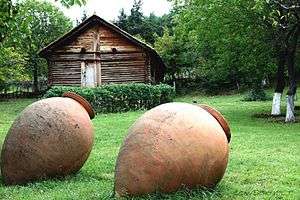
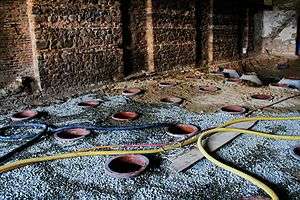
The classical wine production is done in Kvevris, clay jugs, which is the most important distinction from other wine regions like France. Even though modern methods like metal and plastic tanks slowly take over, they are still unwooded and greatly influence the taste of Georgian wine.
Some wineries (especially the Teliani Tsinandali Winery) will give nice, commercial tours to anyone who shows up, whenever they show up, which include wine tasting. As a matter of fact, if you go to any of the wineries and ask for a tour, you will get one, although they may not be very professional about it (and may not charge you anything). Because nearly all of Georgia's high quality wine is exported, and because there are not many tourists in Kakheti, it can actually be impossible to buy wine directly from smaller wineries (even under the table!). Wineries that are not licensed to sell directly to visitors should have an official store nearby, but be sure to call ahead of time to make sure that it is open.
But of course the best drinking opportunities are in the homes of the ordinary people of Kakheti. Nearly every household has its own homemade, usually delicious wine. If you are the least outgoing and speak either Georgian or Russian, chances are you will get invited into someone's home for wine and food – do not pass this up! Your host may also offer you Georgian chacha, an outrageously potent vodka distilled from grapes, which you may indeed want to pass up.
- 🌍
Tsinandali Winery (200-300 m before Shumi Winery). The Tsinandali Winery is more than just a winery, it is also a large and attractive estate-park, with a large manor owned by former President Eduard Sheverdnadze. Originally, the aristocratic poet Alexander Chavchavadze built his cottage here in 1835. In 1886, the vineyard was founded, after successfully fighting the vine fretter. Many of the cellars were built for storing millions of litres of wine. The treasury still contains about 16,500 bottles, which are stored at 10-14 °C and at a humidity of 60-70 %. About 500 bottles originate from the 19th century, though their quality is in doubt.
The winery gives nice and commercial tours to anyone who shows up. Though, they want you to pay (separately) for: (1) looking at the garden, (2) viewing at the wine museum, and (3) 20 lari fixed price and quantity of wine tasting (there is no choice to try fewer/more wines and/or quantity). 7 lari - park, museum & 1 glass of wine; 20 lari - the same as previous one + 6 wines for tasting.. - 🌍 Shumi Winery (200 m northwest from Tsinandali Gardens). They provide complimentary wine tasting and their wine museum is free to view as is their property. Though, it appears they have now adopted their neighbour's approach and offer wine tasting including 3 wines for 15 lari. There also a shop selling their own wine with prices 10-35 lari per bottle.
- 🌍 Kindzmarauli Winery. Kindzmarauli is a delicious sweet red wine, which has been made for centuries, but the winery is a stark lesson in underinvestment. There are no regular tours, but if you just show up, people will be more than happy to show you around.
- 🌍 Marani Winery, Kurdgelauri (5 km north of Telavi), ☎ +995 350236111, e-mail: info@marani.co. cellar tours: Mo-Fr, 10-16:00; tasting: 10-16:00. 11-12€.
- 🌍 TEMI Community, Gremi (2 km from the Gremi Cathedral), ☎ +995 591633633, e-mail: sales@temi-community.org. Ecological wine produced by a community of deprived but very friendly people. Often English, German or Russian speaking people are present to help with the choice. Wine tastings, the opening of a Kvevri or the self-production of Tshurtshchela, a walnut grape delicacy, are offered for 2 or more people. single presentation 4-10 lari p.P., as a whole (tasting, meal, Kvevri, singing, etc.) 55 lari p.P. when ordered 3 days in advance.
- 🌍 Twins Wine Cellar, Napareuli.
Sleep
Many homestay opportunities exist in this region, ask around or follow the local signs.
- 🌍 Kiwi Guest House, 35, Vashlovani St, Lagodekhi, ☎ +995 557499489, +995 551245072, e-mail: thekiwihouse.lagodekhi@gmail.com. A family run guest house, operated by the owners children and friends. From 30 lari.
- 🌍 Guesthouse Vashlovani, 92, Vashlovani St, Lagodekhi, ☎ +995 599856657. The owner speaks Russian and English, and also offers various kinds of meals.
- 🌍 Lopota Lake Resort and Spa (ლოპოტა), Napareuli, Lopota Valley, Kvareli, ☎ +995 32 2 400 400, e-mail: info@lopota.ge. Check-in: 12:00, check-out: 12:00. This resort is in the beautiful Lopota Valley, surrounded by ridges of the Caucasian mountain range, and it has a recreation area stretched over 1 million m².
Stay safe
- Hiking in the steppe of David Gareja and Vashlovani, it is important to carry enough water and to put on proper sunscreen. There are only a few shops or wells around. Also pay attention to snakes, some of which can be poisonous.
- Near Lagodekhi, in summer 2012, a group of armed men from Dagestan crossed the border illegally and took several local people hostage. According to Georgian police, the Islamist terrorists were fought successfully and killed, without hurting any of the hostages. Therefore, it might advisable to avoid hiking too close to the border, even though the danger of renewed incidents is very low. Read more on this here: https://en.wikipedia.org/wiki/Lopota_incident
Go next
There is no onward travel within Georgia, and you will probably return to Tbilisi first and continue travelling from there.
However, if you head southeast past Lagodekhi, you will enter the beautiful Sheki Region of Azerbaijan. There are regular (mini)buses from Tbilisi to Qax (Qakh) and Zaqatala (at least three a day), which you might be able to board along the way if you reserve ahead. There might also exist (mini)buses from Gurjaani or Lagodekhi.